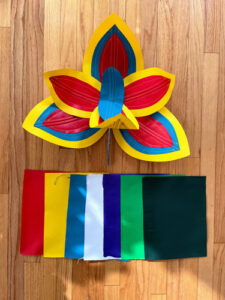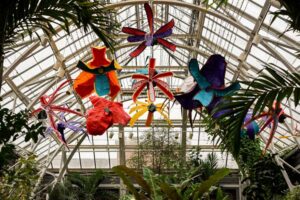Compiled and edited for length by Liz Nye, New England Botanic Garden staff
February 2024
The Garden’s annual orchid exhibition, opening soon on Saturday, February 10, is one of the most highly anticipated events of the year. Imagine conservatories–already beautiful, warm, and lush with plants–made even more magical by the presence of thousands of living orchids, blooming in captivating colors and forms you may have never encountered before.
To complement the stunning displays in this year’s exhibition, Patterns in Bloom, the Garden partnered with Connecticut-based artist Molly Gambardella for a sculpture installation. Like the orchids themselves, Molly’s large-scale, orchid-inspired sculptural pieces are sure to wow. We caught up with her to learn more about her art, her inspiration, and the innovative, sustainability-minded approach she brings to her work.
Liz: Let’s start at the beginning. Did you know you always wanted to be an artist? As a little kid, did you picture yourself doing this?
Molly: I never thought I would end up as an artist until it happened. It was one of those things that everyone else knew before I did. And I kind of tried to fight it and go mainstream. In high school, for example, I was making large–scale sculptures and installations, but I still thought I could be an anesthesiologist because that’s a stable job. But really, I have always gravitated towards sculpture and installation. Since I was a little kid, I enjoyed making these environments and changing spaces that I was in. Toward the end of my undergrad experience at Paier College of Art, I was finally like, ok, I’m a fine artist, and luckily, there was this piece that I made as an undergraduate student that really jump–started my whole career and gave me a confidence boost to do this.
Liz: So, tell us a little about how you’re helping to transform the Garden’s conservatory spaces for Patterns in Bloom? What’s been most inspiring to you throughout the process of putting these sculptures together?
Molly: Orchids are just so fascinating visually that I immediately got giddy and turned to research. Not to anthropomorphize orchids, but I saw the polka dots, I saw the stripes, I saw these patterns, and when I zoomed out, I saw all of them seem to have these faces, these personalities in the centers of the flowers. Ultimately, there is this overall pattern no matter what orchid I’m looking at, because they are so diverse. This immediately created a connection for me between the orchid flowers and humans.
I also love playing with scale. Some of the sculptures are smaller, but the bigger ones are about eight feet. I hope visitors will find them interactive and see what I was seeing in a playful way. I intentionally worked hard to ensure each piece was unique. So even though there’s a limited color palette, every single one is different. That was important to me because while learning about orchids, it was obvious that they each had such a specific way of existing in the world that I thought was so beautiful and metaphorical to humans in every way.
Liz: All the sculptures in the exhibition are made with repurposed single-use plastic bags. This really resonates with the Garden’s values of environmental stewardship and sustainability. Why did you choose this medium?
Molly: I have always gravitated toward materials that are intended for a single purpose. The first time I used single-use plastic bags as a sculpting material I was a teenager. I wanted a messenger bag for cycling, and I wanted it to be waterproof. Something I watched on YouTube led me to play with plastic garbage bags, heating them with my grandma’s iron. My grandma lost a lot of things because I used them for craft purposes. I went back to the same method a couple years ago with my first exhibit at the Garden, Proboscis Paradise, a series of large outdoor floral sculptures that were part of the Garden’s exhibition Wild Hideaways. I teach now, and I always tell my students, if you have an idea that you had as a kid, it’s always better as an adult to reestablish it. You have a lot more skills. I learned a lot about using plastic bags as a building material from Proboscis Paradise. For that exhibit I repurposed plastic bags that I collected or that people donated to me. I found that there are different kinds of plastic bags, and they all have different properties, heating points, and tensile strength when you pull on them. That installation informed my methods for this upcoming one.
Liz: How do the sculptures come together?
Molly: Creating material from plastic bags is a really long process. There are all the steps involved like cutting certain parts of the bags off, heating the bag at the right temperature and for the right time on each side, and putting the right amount of pressure down. I have what’s like a giant panini press that I put individual bags through until they become this material that I can melt together and form a roll. Then the strips of plastic material are laid out to fill the pattern I made, like a petal, for example, and then mended long ways together. Then I cut, trace, cut, and sew so that each one has several layers. Each flower form also incorporates a stainless-steel frame and most include a fiberoptic center.
Liz: What do you hope visitors will take away when they experience the show?
Molly: What I would like people to see is that we’re all different and that this diversity is a strength. It’s seen as something that’s more exciting. I thought about this a lot when I was making all these sculptures, that it would have been so much easier for me to make the same thing over and over again—same color, same size, same pattern would have been a million times easier. But the most important part is that each one is different.
You can experience Molly’s work as part of Patterns in Bloom, An Orchid Exhibition February 10 – March 17. Patterns in Bloom is included in general Garden admission. Join us for special festivities and an opportunity to meet Molly and ask her your own questions on Opening Weekend, February 10 and 11!
Keep learning about orchids: “Orchids don’t like ice cubes, and other must-knows about one of the planet’s most fascinating plant families,” February 2023




